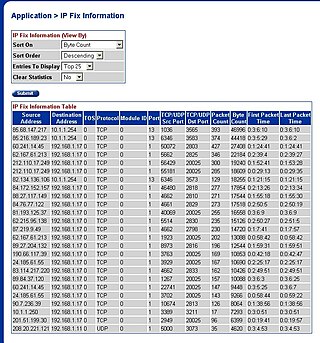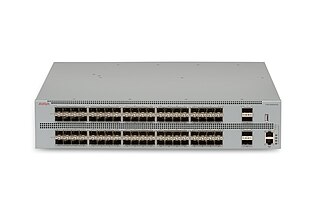A network switch is networking hardware that connects devices on a computer network by using packet switching to receive and forward data to the destination device.
Fibre Channel (FC) is a high-speed data transfer protocol providing in-order, lossless delivery of raw block data. Fibre Channel is primarily used to connect computer data storage to servers in storage area networks (SAN) in commercial data centers.

Small Form-factor Pluggable (SFP) is a compact, hot-pluggable network interface module format used for both telecommunication and data communications applications. An SFP interface on networking hardware is a modular slot for a media-specific transceiver, such as for a fiber-optic cable or a copper cable. The advantage of using SFPs compared to fixed interfaces is that individual ports can be equipped with different types of transceivers as required, with the majority including optical line terminals, network cards, switches and routers.

The IBM BladeCenter was IBM's blade server architecture, until it was replaced by Flex System in 2012. The x86 division was later sold to Lenovo in 2014.
The current portfolio of PowerConnect switches are now being offered as part of the Dell Networking brand: information on this page is an overview of all current and past PowerConnect switches as per August 2013, but any updates on current portfolio will be detailed on the Dell Networking page.

Metro Ethernet Routing Switch 8600 or MERS 8600 is a modular chassis router and/or switch manufactured by Nortel now acquired by Ciena. The MERS 8600 supports the Provider Backbone Bridges (PBB), Provider Backbone Transport (PBT) technologies and carrier class Operations Administration & Maintenance (OAM) tools.

The Ethernet Routing Switch 5500 Series or is a series of stackable, Layer 3 switches used in computer networking. The ERS 5000 was originally designed by Nortel and is now manufactured by Avaya. Up to 8 ERS 5000 Series Switches may be stacked in a 640 Gbit/s fast stacking configuration. This Switch was used as the access layer device for the 2010 Winter Olympics games. The 817 Access Switches supported 8782 Voice-over-IP telephones.

A stackable switch is a network switch that is fully functional operating standalone but which can also be set up to operate together with one or more other network switches, with this group of switches showing the characteristics of a single switch but having the port capacity of the sum of the combined switches.
The Cisco Nexus series switches are modular and fixed port network switches designed for the data center. Cisco Systems introduced the Nexus Series of switches on January 28, 2008. The first chassis in the Nexus 7000 family is a 10-slot chassis with two supervisor engine slots and eight I/O module slots at the front, as well as five crossbar switch fabric modules at the rear. Beside the Nexus 7000 there are also other models in the Nexus range.
Juniper E-Series is a series of broadband services routers or edge routers manufactured by Juniper Networks. The E series was originally developed by Unisphere Networks, which Juniper acquired in 2002. These routers provide multiple services including broadband remote access server, broadband video services, dedicated access, 802.11 wireless subscriber management, VOIP, internet access, security services, network address translation (NAT) etc. on a single platform. The carrier-class architecture of E-series routers allows to combine Broadband Remote Access Server (B-RAS) and dedicated access capabilities on a single and integrated platform. The E-series routes runs on JUNOSe software compared to other series of routers of Juniper which runs on JUNOS.

10 Gigabit Ethernet is a group of computer networking technologies for transmitting Ethernet frames at a rate of 10 gigabits per second. It was first defined by the IEEE 802.3ae-2002 standard. Unlike previous Ethernet standards, 10GbE defines only full-duplex point-to-point links which are generally connected by network switches; shared-medium CSMA/CD operation has not been carried over from the previous generations of Ethernet standards so half-duplex operation and repeater hubs do not exist in 10GbE. The first standard for faster 100 Gigabit Ethernet links was approved in 2010.

Ethernet Routing Switch 5600 Series or in computer networking terms are stackable routers and switches designed and manufactured by Avaya. The ERS 5600 Switches can be stacked up to 8 units high to create a 1.152 Tbit/s backplane through the Flexible Advanced Stacking Technology (FAST) stacking technology configuration. The 5600 Series consists of five stackable models that can be mixed and matched together with other ERS 5600 models or other ERS 5500 models to meet configuration requirements. Additionally the ports on the switches incorporates the Avaya Energy Saver (AES) which can manage and dim down the power requirements to save energy across all switches in the enterprise.

The Dell blade server products are built around their M1000e enclosure that can hold their server blades, an embedded EqualLogic iSCSI storage area network and I/O modules including Ethernet, Fibre Channel and InfiniBand switches.
Avaya Virtual Services Platform 7000 Series or VSP 7000 is a set standalone/Stackable Switches, used in enterprise data networks, and data centers, manufactured by Avaya. This product is primarily offered to satisfy the Top-of-Rack (ToR) role for server farms and virtualized data centers. It supports Avaya's extended Shortest Path Bridging (SPB) implementation "Fabric Connect", and is future-ready for Edge Virtual Bridging (EVB) – IEEE 802.1Qbg, and Fiber Channel over Ethernet (FCoE). The system incorporates fifth generation application-specific integrated circuit (ASIC) chips with redundant and hot-swappable power supplies, fans, and expansion modules. The VSP 7000's unique architecture allows it to be meshed—fully or partially—with like devices, creating a high-capacity, low-latency network of up to 500 units, supporting up to 16,000 ports of 10GbE supported by a virtual backplane of up to 280 Tbit/s

Ethernet Routing Switch 3500 series and Ethernet Routing Switch 2500 series or ERS 3500 and ERS 2500 in data computer networking terms are stackable routing switches designed and manufactured by Avaya.
Dell Networking is the name for the networking portfolio of Dell. In the first half of 2013, Dell started to rebrand their different existing networking product brands to Dell Networking. Dell Networking is the name for the networking equipment that was known as Dell PowerConnect, as well as the Force10 portfolio.
SwitchBlade is the registered name of a family of layer 2 and layer 3 chassis switches developed by Allied Telesis. Current models include the SwitchBlade x908 GEN2 and the SwitchBlade x8100 layer 3 chassis switches. The first model was the SwitchBlade 4000-layer 3 core chassis, which ran the earlier AlliedWare operating system.
The Avaya Virtual Services Platform 4000 series are products that, in computer networking terms, are standalone switch/routers designed and manufactured by Avaya for Ethernet-based networks. The VSP 4000 hardware is a derivative of the earlier Ethernet routing switch 4000 series, leveraging certain shared components, but implementing a new, completely different, operating system derived from the virtual service platform 9000 series. The role of the VSP 4000 is to extend fabric-based network virtualization services to smaller, remote locations, thereby creating a single service delivery network.

The Avaya Virtual Services Platform 8000 Series, or VSP 8000, is a standalone Ethernet Switch manufactured by Avaya, and intended for use in Campus network and Data Center deployment scenarios.








